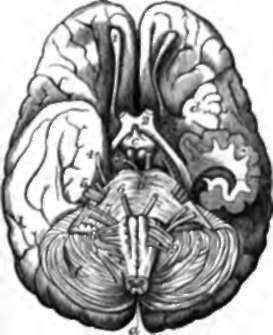144. Structure Of The Encephalon
Description
This section is from the book "Animal Physiology: The Structure And Functions Of The Human Body", by John Cleland. Also available from Amazon: Animal Physiology, the Structure and Functions of the Human Body.
144. Structure Of The Encephalon
The brain or encephalon, the portion of the cerebro-spinal axis contained within the cranium, consists of various parts to which different names are given. The part in continuity with the spinal cord, as has already been mentioned, is called the medulla oblongata. It is about an inch and a quarter long, and broadened above, and in it both the white and grey matter have a different arrangement from that existing in the cord. In front are the columns called anterior pyramids, whose decussation has already been mentioned; outside these are the olivary bodies, each containing a grey centre of unknown function; while outside these are two stout pillars called restiform bodies, including the posterior half of the lateral columns of the cord, and all the fibres of the posterior columns with the exception of two small bands behind, distinguished as posterior pyramids. These and the restiform bodies slope outwards as they ascend, and limit at the back of the medulla oblongata a groove lined with grey matter, continued up from the central canal of the spinal cord. This groove forms the floor of what is called the fourth ventricle of the brain, a space between the medulla oblongata and the cerebellum.
Above, the medulla oblongata is crossed in front by a thick transverse band, called the pons Varolii, which conceals the continuation of the fibres of the medulla upwards to the cerebrum, and sends its fibres into the cerebellum on each side. Below them the restiform bodies enter the cerebellum, and thus are formed what are called the middle and inferior crura cerebelli; while the superior crura are a pair of bands which pass from the cerebellum to the cerebrum. All the 14 N fibres of the medulla oblongata, with the exception of the restiform bodies, pass up to the cerebrum.

Fig. 99. Under Surface of Brain. a, Spinal cord cut across below the medulla oblongata: on the latter are seen, from the middle line outwards, anterior pyramids, olivary bodies, and restiform bodies. b, Pons Varolii; c, infundibulum (the pituitary body having been removed); d, gyri operti, or island of Reil; e, section of descending cornu of the left lateral ventricle, displayed by removal of part of the middle lobe of the hemisphere, exhibiting sections of the tænia hippocampi and hippocampus major; f, cerebellum. 1, Olfactory bulb; 2-9, successive cranial nerves, marked each with its proper number.
The cerebellum is a large mass of brain substance covered on the surface with grey matter arranged in complex transverse laminæ, with folds of pia mater between them. Its main bulk in the human subject consists of two large lateral lobes; but between these, in a depression or vallecula below, there is another portion, the inferior vermiform process; while above there is an elevation where the lateral lobes meet in the middle, the superior vermiform process; and what gives a special significance to these processes is, that they correspond with a middle lobe of the cerebellum in other mammals, which in the lower orders forms the greater part of the structure. In birds there are no lateral lobes, and in osseous fishes the cerebellum is reduced to a mesial pouch, without lamination, whose hollow is an expansion upwards of the continuation of the original central canal. In the human subject this hollow is seen in the roof of the fourth ventricle, in front of the inferior vermiform process.
The medulla oblongata, pons Varolii, and cerebellum, which may be termed collectively the epencephalon (Owen), occupy an inferior compartment in the back part of the cranium; the cerebellum being roofed in and separated from the rest of the brain above it by a septum of dura mater called the tentorium, cere-belli, which in some animals, as the cat, even contains a lamina of bone.
Continue to:
- prev: Chapter XIII. The Nervous System
- Table of Contents
- next: 145. The Whole Of The Brain Above The Level Of The Tentorium
